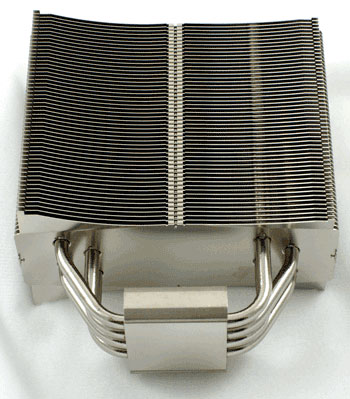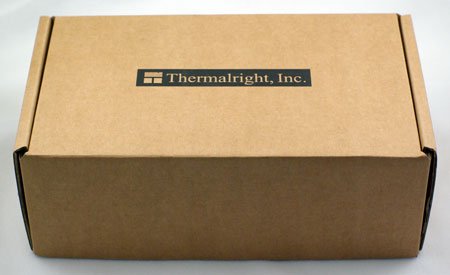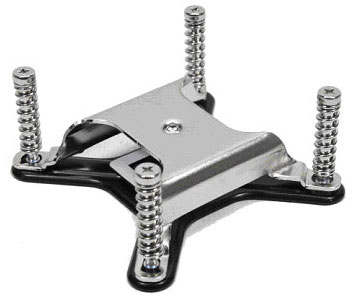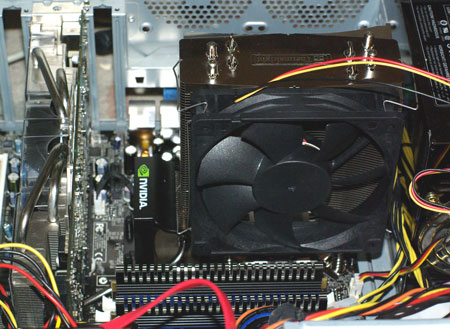Thermalright Ultra 120: Elegant, Fanless and Efficient Cooling
by Wesley Fink on March 5, 2007 12:05 AM EST- Posted in
- Cases/Cooling/PSUs
Thermalright Ultra 120
Thermalright specializes in the enthusiast market, manufacturing the usual CPU coolers but also chipset, VGA, and RAM coolers, as well as thermal paste. Thermalright emphasizes their design capabilities in the cooling market, and their advanced manufacturing processes are ISO-9000 certified.
Most hobbyists first heard of Thermalright when their SK-6 cooler appeared in the summer of 2001 and started winning most of the heatsink roundups. Since then Thermalright has become a well-respected name in high-end air cooling. Thermalright produced several well-known heatsinks for the AMD K8 and Pentium 4 sockets, such as the XP-120 and XP-90 heatsinks. You bought the Thermalright heatsink and paired it with the 120mm or 90mm fan of your choice - for low noise or massive air flow or some combination that met your needs.

The Thermalright Ultra 120 is a top-of-the-line heatsink. As the top model in the current Thermalright lineup it is targeted at enthusiasts who want the best and most flexible performance available in a CPU cooler. The Ultra 120 mounts 120mm fans, but there is also a smaller and lighter version called the Ultra 90 that logically mounts 92mm fans.

The Ultra 120 comes packaged in the usual plain brown Thermalright box. All the Thermalright coolers we have seen are shipped in sturdy natural cardboard boxes. Some would argue the name says it all. Like Godiva in chocolates, Thermalright says you have the best. Whether Thermalright really is the best is what this review will help determine.

Inside the box you will find an exceptionally well-protected Ultra 120 heatsink, along with everything you need to mount the Ultra 120 on an Intel Socket 775 or an AMD Athlon 64/FX/X2/Opteron.

For AM2 you will need to purchase an Ultra-120 AM2 adapter, which sells for about $8. The Ultra 120 is not currently available in an AM2 version right out of the box. The smaller Ultra-90 does come in an AM2 version.
The Thermalright Ultra 120 kit is available for around $47 retail. The Ultra 90 sells for a little less, around $40. You will also need a 120mm fan such as the Scythe S-Flex SFF21F or the Noctua fans. Just keep in mind that the fan needs holes for the fan wires to work - solid post fans will not work. At a total cost for heatsink and fan of around $50 to $60 the Thermalright is competitively priced with other top heatsink towers like the Tuniq Tower 120 and the Scythe Infinity.

The Scythe S-Flex fan that was tested with the Thermalright comes with just a 3-pin connector. It can be powered directly by the board, or if you are concerned about current draw Scythe provides a 4-pin Molex to fan adapter. Since there is no 4-pin connection you will need something like the Zalman Fan Mate controller if you want to vary the fan speed of the S-Flex. On motherboards supported by Speed Fan, that free software utility is also an option for controlling fan speed.

Installing the Ultra 120 is relatively easy, but you will need to remove the motherboard from the case to install. A mounting plate rests on the back of the board with screw pegs passing through the mounting holes on the board. The heavy Ultra 120 is then supported by four spring-loaded screws on a mounting plate that covers the entire top of the CPU mounting block.

Thermalright has developed a very logical method of installation that provides security for the heavy Ultra 120 heatsink. There was never a worry that the Ultra 120 would fall off the board or rip out of the mounting holes. However, caution is still needed in moving a system with the Ultra 120. The heatsink weighs 745g and the fan we used is 180g. That total weight of 925g is just over two pounds.

We had no problems during testing and moving our test tower around. However, constantly moving a tower system with this kind of cooler weight supported by the motherboard could over flex the board and cause failure.
Specifications
Our test system is Intel Socket 775, but the Thermalright Ultra 120 will also mount on any AMD 754/939/940 CPU with the included adapter. An optional AM2 adapter is needed for that socket.
S-Flex fans are available in other noise and air flow specifications to meet your needs. The SFF21D has an 8.7dB-A noise rating at 33.5CFM, while the mid-range 21E is 20.1 dB-A at 49.0 CFM. Noctua also has a wide range of fans that will fit the Ultra 120. You will find a wide selection of fans available at etailers like Newegg or Frozen CPU.
Thermalright specializes in the enthusiast market, manufacturing the usual CPU coolers but also chipset, VGA, and RAM coolers, as well as thermal paste. Thermalright emphasizes their design capabilities in the cooling market, and their advanced manufacturing processes are ISO-9000 certified.
Most hobbyists first heard of Thermalright when their SK-6 cooler appeared in the summer of 2001 and started winning most of the heatsink roundups. Since then Thermalright has become a well-respected name in high-end air cooling. Thermalright produced several well-known heatsinks for the AMD K8 and Pentium 4 sockets, such as the XP-120 and XP-90 heatsinks. You bought the Thermalright heatsink and paired it with the 120mm or 90mm fan of your choice - for low noise or massive air flow or some combination that met your needs.

The Thermalright Ultra 120 is a top-of-the-line heatsink. As the top model in the current Thermalright lineup it is targeted at enthusiasts who want the best and most flexible performance available in a CPU cooler. The Ultra 120 mounts 120mm fans, but there is also a smaller and lighter version called the Ultra 90 that logically mounts 92mm fans.

The Ultra 120 comes packaged in the usual plain brown Thermalright box. All the Thermalright coolers we have seen are shipped in sturdy natural cardboard boxes. Some would argue the name says it all. Like Godiva in chocolates, Thermalright says you have the best. Whether Thermalright really is the best is what this review will help determine.

Inside the box you will find an exceptionally well-protected Ultra 120 heatsink, along with everything you need to mount the Ultra 120 on an Intel Socket 775 or an AMD Athlon 64/FX/X2/Opteron.

For AM2 you will need to purchase an Ultra-120 AM2 adapter, which sells for about $8. The Ultra 120 is not currently available in an AM2 version right out of the box. The smaller Ultra-90 does come in an AM2 version.
The Thermalright Ultra 120 kit is available for around $47 retail. The Ultra 90 sells for a little less, around $40. You will also need a 120mm fan such as the Scythe S-Flex SFF21F or the Noctua fans. Just keep in mind that the fan needs holes for the fan wires to work - solid post fans will not work. At a total cost for heatsink and fan of around $50 to $60 the Thermalright is competitively priced with other top heatsink towers like the Tuniq Tower 120 and the Scythe Infinity.

The Scythe S-Flex fan that was tested with the Thermalright comes with just a 3-pin connector. It can be powered directly by the board, or if you are concerned about current draw Scythe provides a 4-pin Molex to fan adapter. Since there is no 4-pin connection you will need something like the Zalman Fan Mate controller if you want to vary the fan speed of the S-Flex. On motherboards supported by Speed Fan, that free software utility is also an option for controlling fan speed.

Installing the Ultra 120 is relatively easy, but you will need to remove the motherboard from the case to install. A mounting plate rests on the back of the board with screw pegs passing through the mounting holes on the board. The heavy Ultra 120 is then supported by four spring-loaded screws on a mounting plate that covers the entire top of the CPU mounting block.

Thermalright has developed a very logical method of installation that provides security for the heavy Ultra 120 heatsink. There was never a worry that the Ultra 120 would fall off the board or rip out of the mounting holes. However, caution is still needed in moving a system with the Ultra 120. The heatsink weighs 745g and the fan we used is 180g. That total weight of 925g is just over two pounds.

We had no problems during testing and moving our test tower around. However, constantly moving a tower system with this kind of cooler weight supported by the motherboard could over flex the board and cause failure.
Specifications
Our test system is Intel Socket 775, but the Thermalright Ultra 120 will also mount on any AMD 754/939/940 CPU with the included adapter. An optional AM2 adapter is needed for that socket.
| Thermalright Ultra 120 Specifications | |
| Heatsink | |
| Dimensions | 63.5(L) X 132(W) X 160.5(H)mm (excluding fan) |
| Weight | 745g (excluding fan) |
| Material | Nickel-plated Copper and Aluminum |
| Fan Configuration | Supports 120mm fans with open mounting posts |
| Optional Fan | |
| Model | Scythe S-Flex SFF21F |
| Fan Size | 120mm x 120mm x 25mm |
| Bearing Type | Sony Fluid Dynamic Bearing |
| Noise Level | 28.0 dbA |
| Speed | 1600 rpm |
| Air Flow | 63.7 CFM |
| Fan Life | 150,000 hrs (vs. 50,000 hrs for ball bearing) |
| Weight | 180g (fan only) |
S-Flex fans are available in other noise and air flow specifications to meet your needs. The SFF21D has an 8.7dB-A noise rating at 33.5CFM, while the mid-range 21E is 20.1 dB-A at 49.0 CFM. Noctua also has a wide range of fans that will fit the Ultra 120. You will find a wide selection of fans available at etailers like Newegg or Frozen CPU.










30 Comments
View All Comments
hox - Thursday, March 8, 2007 - link
I would like to know what you have enabled or disabled in the bios that controls CPU automatic throttling. Typically that would include Enhanced C1 control (C1E), SpeedStep, and for my Asus MB, something called CPU internal thermal control.These settings affect how the cpu "handles" load and will affect the temps reported to the Ntune program. Programs like CpuZ and Coretemp and Ntune do not detect some of these rapid throttling instances, but the temps of the processor are reduced because of this throttling. The Righmtark CPU temp utility is one of the few programs I know that allows you to visualize this throttling even when you have several of the throttling paramters disabled.
This issue is important because the temps you are seeing, even at idle, are very different for several of your reviewed heatsinks then what end users will experience when they have altered these parameters in the bios.
I believe this will be helpful for end users to feel like the products your reviews are deeming as superior are performing in their hands in a manner similar to your review. Please provide the bios settings to help the end users decide if the equipment they have purchased is functioning properly.
I suspect by doing this, many RMAs and emails to the manufacturer would be reduced.
There is a clear 10C difference between the reported CPU temps at both idle and full load for my QX6700 cpu caused by changing these three settings. Enabling these parameters in the bios I routinely see temps of 33 to 35 C for the cores of my QX6700 at stock speeds, MB temp is 35C. Disabling these parameters, temps on all 4 cores rise to 44C. Thus discrepancy in temps could lead someone to think that the Monsoon II lite cooler I am using is malfunctioning, when in reality it is working properly.
Also it would be helpful if you also tested these devices with the quad core processors which have a higher heat output. By testing the quad core cpus the high end capacity of these heat sinks to move heat would be tested. Providing the thermal resistance Degrees C/Watt would also be a helpful guideling for these devices.
It would also be helpful to comment whether the side door will fit with the thermalright heat sinks. As far as I know this heat sink is taller than the Tuniq which caused end users to move side panel fans and vents.
Thank you
arswihart - Tuesday, March 6, 2007 - link
I think you should consider retesting the Monsoon II Lite. As the only heatsink to make it to 3.96ghz on your OC tests, and with a full 6C increase in temp at 3.90ghz compared to the Ultra 120, I question whether you can replicate your results with the Monsoon at this point. We all know transistors age with OC'ing, and it is possible that your CPU has actually degraded in performance since you tested it with the Monsoon.There's no reason to think that the Monsoon enabled your CPU to reach 3.96ghz by some magical effect apart from it's cooling ability, which is 6C worse that the Ultra 120 at 3.90ghz.
arswihart - Tuesday, March 6, 2007 - link
Sorry my fault I mis-stated the temp difference at 3.90ghz between the two heatsinks, it is actually a paltry 2C!I think it still might be worthwhile to retest the Monsoon, just because the Tuniq Tower and today's Ultra 120 were unable to reach 3.96ghz even with comparable or better cooling at 3.90ghz.
muddocktor - Monday, March 5, 2007 - link
This is a decent review of the Ultra 120 Wesley, good job. But like another person posted, I also had gotten an Ultra 120 with a bad base finish. In my case, there was a machining ridge left on one side of the base that interfered with getting a flush mount plus the base was fairly concave too. And my initial testing of it (with those defects) found the performance to be no better than the stock Intel heatsink. After I filed the ridge down on the edge, then lapped the base of the Ultra 120 to be flat, the performance was much like the performance that you had with yours. I also tested it with both the S-Flex fan you chose plus I tried the Tuniq Tower's fan too(I also have one of those heatsinks) and saw very little difference in cooling ability with either fan mounted on either heatsink. So for the folks that want to swap out the Tuniq Tower's stock fan with the 63 cfm S-Flex you will only lose a minimal amount of performance and the S-Flex is noticeably quieter.Also in testing my Ultra 120, I tested on a socket 939 AMD system too and ran into a mounting orientation problem with my motherboard. Since AMD doesn't use a square mounting pattern on socket 939 (or 754 or 940 or AM2 for that matter), you can't just change the mounting direction by simply rotating the heatsink 90 degrees. Thermalright does make an "S" clip for this though, which I also tried out. The "S" clip is a real PITA to mount with but does do the job effectively and gives you a decent mount.
Finally, with the Ultra 120 you have the ability to mount different thickness fans too, unlike the Tuniq Tower. You can easily use any of the Panaflo 120 X 38 mm fans and if you are brave enough you can even mount the Delta GFB1212VHW 120 X 76 mm fan if you think it would help in cooling (I don't think so as there seems to be a point of diminishing returns on added cooling efficiency with this heatsink past 60-70 cfm with a moderate max static pressure fan).
The biggest problem I see with Thermalright's products lately is the somewhat variable nature of their quality control on base finish. I've also gotten some XP90's in the last year or so with concave base finishes that required lapping too. But other than that, Thermalright has some of the best designs on the market in my opinion.
takumsawsherman - Monday, March 5, 2007 - link
I have been having good success with the HR-01 from Thermalright, so I am glad to see this review which more accurately measures the performance of *this* heatsink versus competitors, which looks even better than the HR-01 in terms of construction quality (the HR-01, despite its good performance, looks unfinished).As far as the stock Intel coolers go, I have been pleasantly surprised by the latest generation of both Intel and AMD stock coolers. Though I recently replaced a customer's late model P4 stock heatsink (LG775 3.04 Prescott) with an HR-01 with Scythe SFF21F because of crazy temps that were causing the system to power down. Tried adjusting the heatsink, and when cleaning and reapplying thermal paste to the stock cooler I noticed that as opposed to the copper core of the C2D coolers, this had a chrome-like metal. After reinstallation, the temperature at idle was still crazy hot, with no apparent reason (Intel board, voltages looked OK, no overclocking, etc.. After installing the HR-01, idle dropped to 32C, full load after 20 minutes was 47C-49C.
As an aside, I am really not digging the new Intel fasteners. There always seems to be one that doesn't want to go in easily, and/or you can't hear the click. Then I go nuts trying to verify whether or not it is really in. Hopefully, AMD will not follow that system.
gramboh - Monday, March 5, 2007 - link
Awesome review, I love the amount of detail and variables involved in the test, very comprehensive and well described.I was set on a Tuniq but after being frustrated by how hard they are to get in Canada, I am going to go with an Ultra 120 instead. My current PC (4 year old P4 2.6 Northwood @ 3.25) has been cooled with a Thermalright SLK-900U (copper) and has been stablewith a 625MHz OC for 4 years. I like the company.
Anyone know if there are any fit issues using the Ultra 120 with a Asus P5B-E in an Antec P180B/P182 case?
Thanks
AbRASiON - Monday, March 5, 2007 - link
Nice article but all it has convinced me is that the intel stock cooler is surprisingly pretty good for "free"It's not too noisy (for a change) it's not holding back overclocking (that much) and it costs 0$
If you're a budget guy, right now an E4300 with the stock cooler is pretty ok for cheap.
Baked - Monday, March 5, 2007 - link
Thank you Anandtech for finally reviewing this HSF. Thermalright is king baby.mforce - Monday, March 5, 2007 - link
I know you specified in your article that an adaptor for AM2 needs to be purchased separately but I don't find this quite normal. I think Thermalright should make an effort and support AM2 out of the box. After all AM2 isn't a new thing , it's been out for quite some time now and it's also here to stay. An extra adaptor costs more and might also be hard to find.Maybe you should ask Thermalright and have an official position as to why it's so hard to support AM2 out of the box. Socket 754 and 939 are cool but they're quite dead.
johnsonx - Monday, March 5, 2007 - link
Are you sure you're describing that correctly? I don't ever recall seeing such a power supply, unless someone screwed up and installed the fan backwards. I agree though that a power supply with a bottom fan would be better suited to cool a fanless heatsink, but because it draws in air FROM the CPU area not blows ONTO the cpu area.